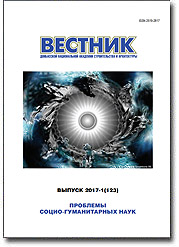The Reformation of Martin Luther: the Background and Reasons (to 500-Etiyu the Reformation)
Abstract: The article describes the situation in the Holy Roman Empire of the German Nation in the second half of the XV century and at the beginning of the XVI century. The economic recovery in Germany in those years leads in a few cases to the emergence of the country’s first elements of early capitalist relations, sharp stratification of the urban population and the growth of contradictions between classes. The economic and political inequality in the development of various lands and cities characterized Germany. Immediately prior to the Reformation social contradictions sharply intensified in the country. Sharp contradictions observed in opposition to secular and ecclesiastical princes. Catholic Church seeks to usurp the role of the divine institutions on the earth. However, the humanists are against the papal domination in Germany, exposing the ignorance and corruption of the church clergy. Many enlightened preachers and theologians turned out to be opposed to papal Rome, demanding the reform of the church. Martin Luther, who published his Ninety-five Theses in October, 1517, became an outstanding representative of this ideological opposition.
Keywords: to preach, to forgive sins, to fight, to protest, the Reformation, the church, the Pope, humanists, dogma, obscurants, indulgences.
Pages: 31-38.
For citation:
For citation: Tsypkin, A. I. The Reformation of Martin Luther: the Background and Reasons (to 500-Etiyu the Reformation). – Text : electronic. – In: <em>Proceeding of the Donbas National Academy of Civil Engineering and Architecture</em>. – 2017. – Issue 2017-1(123) Problems of social and humanitarian sciences. – Р. 31-38. – URL: https://donnasa.ru/publish_house/journals/vestnik/2017/2017-1(123)/st_06_tsipkin.pdf (date of access: 20.05.2025). – ISSN 2519-2817.

Issue 2017-1 (123)
Journal: Proceeding of the Donbas National Academy of Civil Engineering and Architecture
Publish house: Donbas National Academy of Civil Engineering and Architecture
Journal: Proceeding of the Donbas National Academy of Civil Engineering and Architecture
Publish house: Donbas National Academy of Civil Engineering and Architecture
